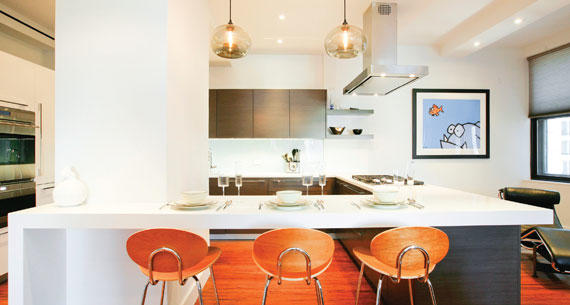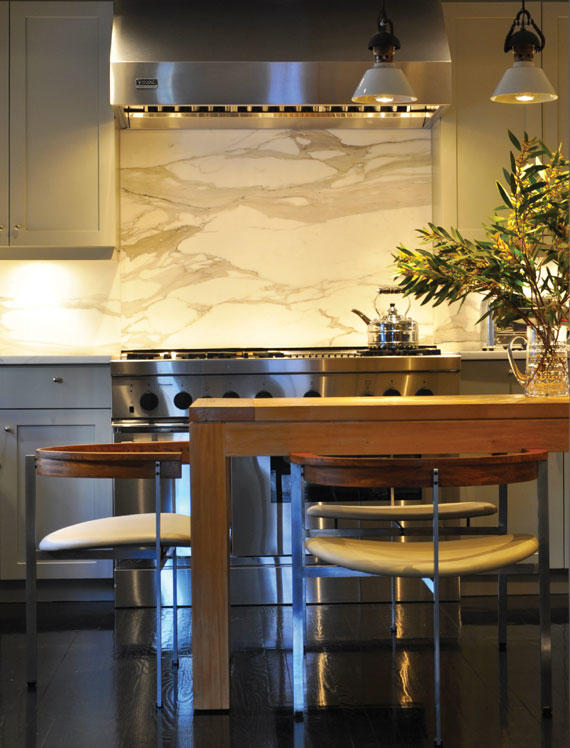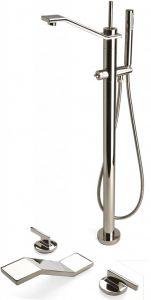Trending
Renovated to inspire desire (and a sale)
How to create stunning kitchens and baths that will move your home off the market

For Manhattan residents looking to sell their homes, an outdated kitchen or bath that had been merely functional before can suddenly become an unwanted focal point.
In some cases, particularly with townhouses, a broker would typically advise owners not to spruce up a kitchen or bath, under the assumption that the new owners will do their own renovation to suit their taste.
But in other situations, putting homes on the market with unloved kitchens and bathrooms can be an invitation to low offers. And dated spaces can be a deal killer for sales in buildings with summer-only renovation rules or when potential buyers can’t stomach the idea of tackling a renovation themselves.
Interior designers, renovation experts and luxury kitchen and bath manufacturers offered Luxury Listings NYC a host of recommendations for creating stunning kitchens and baths, the rooms that all agreed were the most critically inspected by potential buyers.
The experts estimated the cost of a gut renovation for a high-end kitchen to range from $100,000 to $150,000, while baths could cost from $30,000 all the way to $50,000, and much higher for a master.
Condo competition
While those costs could seem steep, consider the big picture: According to Lee Stahl, president of The Renovated Home, many Manhattan homes in the $7 million-to-$20 million range are sitting on the market now because of competition from brand new, move-in-ready condos.
“If you’ve got an estate sale, you must do a renovation in order to avoid leaving money on the table. And no one wants to renovate,” Stahl said, referring to buyers.
Doing a renovation for a home going on the market is a unique proposition. One is faced with creating rooms that are impressive yet not intimidating or turn-offs to buyers because of design choices. In other words, the rooms must be both striking yet nonspecific at the same time.

A kitchen renovation in a West Village home by MADE featuring a backsplash of Calacatta Borghini marble.
Fortunately, there is a blueprint for that look.
“What people have wanted since 2005 are white kitchen cabinets, Calacatta marble counters and dark wood floors,” Stahl said. Countertops with a 2-inch thick edge “turn people on — they’re an aphrodisiac.”
“When do I see this trend ending? I’ll let you know,” he said with a laugh.
“In an estate sale, this is a money-in-the-bank design,” he said. “You don’t need to do insane customization, you don’t need to fly to Italy to pick your own marble.” But with this look, he said, which many buyers consider the ultimate in design, thanks to its appearance in numerous shelter magazine spreads, “you will hit your number.”
Stahl speaks from experience. Take the home at 740 Park Avenue that sat on the market for about a year until Stahl stepped in and made a $100,000 bet with the owner that he would get the project done in a mere 16 weeks. “We dropped over $1 million on the [home’s] renovation and it sold to a well-known person,” he said.
Still on the fence about whether to renovate? Manhattan interior designer Marcia Butler offered this rule of thumb: “If the kitchen and bath are in good shape — meaning there has been a renovation within the last 10 years and there’s nothing outlandish about the spaces — most real estate professionals will say ‘leave it.’ The buyer will move in and eventually renovate. But if it is in bad shape, it is worth it to gut it out. You will get your money back.”
Kitchen capers
Butler and others named what owners must put in their kitchens to make buyers’ hearts pound.
“Select a fridge that is counter-depth at 24 inches, so it is not jutting out,” Butler said. If one has good money to put into a renovation, buyers want to see a Sub-Zero.” Other top brands are Miele, Thermador, Liebherr and Fisher & Paykel.
And freestanding fridges are a no-go. In today’s kitchens, fridges practically disappear. Buyers like to see them covered in the same material as the cabinets to blend in with the space, Butler said, a concept that works especially well in open layouts, where the kitchen bleeds into the rest of the living space.
Buyers also want to see a five-burner stove with a grill in the middle and a wine fridge or dedicated wine storage, if there’s space, Butler said. “In New York City, it is all about space.”
Other fancy appliances making pulses quicken? Microwave drawers, and steam and speed ovens.
Statement appliances are prized, but certain small luxe details are also valued, such as interior lighting for drawers, task lighting over counters, accent lighting at toe kicks and an oversized lighting fixture. Also appreciated are gadgets that lift up televisions, unique faucets and decorative range hoods.
Make it seamless
A favorite trick of Butler’s is to add a custom kitchen island with drawers on both sides. “A nice thing to do is use the same surface on the top and remaining two sides,” she said. The result is a streamlined effect.

A high-end version of a seamless island is the monoblock from Bulthaup. This is a stainless steel workstation that looks like a solid block of metal, with no visible seams between the back, side and top surfaces. And one of Bulthaup’s newest products also offers another neat trick: the shutter island, which features pull-down shutters to hide appliances. It is currently available in laminate, aluminum and stainless steel.
Lainey Guidry, designer for Bulthaup New York, commented on a stylish kitchen trend: “Kitchens are often one material on one element and a completely different one on another element. For example, a kitchen could have one element along a wall in all natural aluminum or white fronts and an island made of wood. It gives a feeling of the kitchen as furniture and brings a bit of warmth to the space.”
While white is still an “incredibly popular choice for many high-end clients,” said Claudia Febres, architectural designer at kitchen manufacturer allmilmö USA Corp., textures add extra allure to cabinet fronts, counter tops, backsplashes and niches or openings for shelving. If the surfaces “reflect the imperfections of nature, even better,” she said. Look for exotic wood veneers, rippled doors, distressed concrete counter tops and tri-dimensional tiles to get this look.
For tile, Butler also suggested Ann Sacks, which she said has a “luxe feel” thanks to its muted tones. For jazzing up kitchens, she recommended Artistic Tile, which has multiple locations in Manhattan.
Butler also likes a variety of materials, including cement counters. “They’re very durable and have a sophisticated yet easy and industrial look too. I also love walnut wood because it is natural and has an interesting grain. I love ash because the grain is huge and with cerusing [a technique that lightens the grain], you can really bring that grain out.”
Tuck it away
Kitchens from Bazzèo perform a disappearing act. That’s because Ana Sternberg, co-founder and CEO, said homeowners want to “create a clean look with lots of working counter space.”
But to get a clean look, one needs excellent storage. Her company often gives kitchens tall pullout pantries or doors with drawers that offer easy access to items. Small appliances can be hidden inside countertop garage-style doors with internal electrical outlets, and appliances can be used inside their storage spaces.
But for the ultimate in smart storage, check out the company’s Pandora line. With James Bond-like wizardry, the line features a motorized kitchen island that opens up to reveal shelves, counters, seating, shelves and cooktops. Another piece in the line features a cabinet that rises up from the island at the push of a button and disappears when not in use. Talk about a clean look!
Sternberg explained that this line works particularly well in homes with “open spaces that do not have walls, as there’s nothing hanging from the ceiling to obscure the view.”
James Bond fantasies aside, putting in a gourmet kitchen in an older New York City building can be tricky.
Ben Bischoff, one of the founding partners of MADE, a NYC design-build practice, reminds home owners that they need to think about ventilation when installing ranges like Viking and Blue Star that are all the rage. “High-end ranges are modeled on restaurant-quality appliances,” he said. “Good ventilation is extremely important.”
There are alternatives for older buildings that can’t be configured for restaurant-quality ventilation, he pointed out. Convection ovens and induction cooking surfaces are both attractive options.
Fancy baths
Bischoff said his goal in creating great bathroom spaces is to “make them feel like rooms.” He likes to create a space for furnishings, such as a chair or storage, because those elements can tie the bathroom into the home and add more comfort, he said.

Formwork faucet and handles
“We think a lot about sinks,” he said. Washstand-style fixtures allow residents to see the floor — this makes the space seem bigger. Other recommendations are to consider whether having a bathtub makes sense; if there are other tubs in the house, consider taking it out.
“A bathroom is a space we spend a lot of time in,” Bischoff said. “Sure, a large bedroom is nice, but we’re asleep most of the time in it. Consider shifting square footage to the bathroom. A good linen closet in an accessible location” is a great attribute, he said.
Luxe touches that homeowners want in their bathrooms, Butler said, include Dornbracht rain showerheads, Duravit toilets and Bendheim glass shower enclosures. “Get rid of the shower curtain,” Butler advised.
According to Peter Sallick, CEO and creative director of Waterworks, “There has been strong interest in an industrial-inspired bathroom space,” which he said is defined by “powerful shapes and unique aesthetic details” and open space. “We see this influence as uniquely urban and uniquely American,” Sallick said.
Waterworks customers frequently request brass, which Sallick called “a living finish that changes with time and attains a patina.” This is particularly popular in the Henry and Highgate collections, he said.
The latest bath collection from Waterworks is Formwork. The modern collection offers slim profiles and a patented water flow technology with more than 60 components, including bath fittings, textiles and surfaces.
Febres of allmilmö favors “floating” cabinetry off the floor, even if that means sacrificing storage, but only if the floor finishes can be shown. Go for less adornment, sculptural fixtures that can stand alone, rain showers of “colossal proportions” and extra-large mirrors instead of the good old medicine cabinet, she advised.
Stahl of The Renovated Home also offered his take on bathroom styling:
“In bathrooms, it’s more Calacatta marble, polished nickel hardware and subway tiles. If you do that in a renovation, you’ll sell, if you do something different, you won’t sell it.”




